-
Rottweilers are prone to certain health issues, including hip dysplasia, bloat, cancer, and heart conditions.
-
Preventative care is crucial, including vaccinations, parasite control, dental care, and regular vet checkups.
-
Proper nutrition plays a vital role in their overall health, with different dietary needs for puppies, adults, and seniors.
-
Regular exercise is essential for maintaining a healthy weight, preventing behavioral issues, and promoting overall well-being.
-
By being proactive and informed, you can help your Rottweiler live a long, happy, and healthy life.
In this guide, we’re diving deep into the world of Rottweiler health. We’ll cover those common health hiccups that Rottie owners should know about, the preventative care that can save you a whole lot of stress (and money!), and all the tips and tricks to keep your Rottie thriving. Consider this your cheat sheet to a happy, healthy Rottie (and maybe a slightly less stressed-out bank account!).
Common Health Concerns: The Rottweiler Lowdown (Concise and Structured)
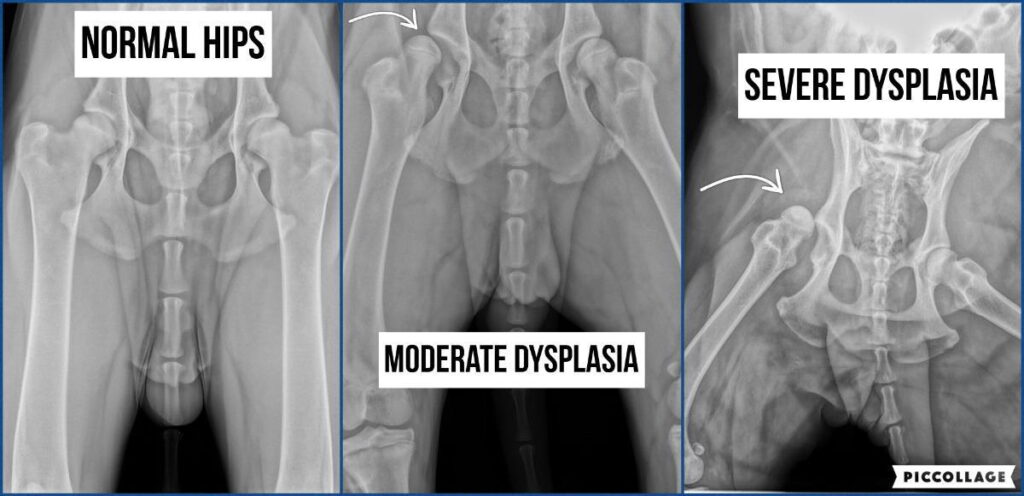
Hip and Elbow Dysplasia: When Those Joints Don’t Jive
Rottweilers are known for their strength and athleticism, but unfortunately, they’re also prone to hip and elbow dysplasia. These are common joint conditions that can cause pain, lameness, and decreased mobility.
What are Hip and Elbow Dysplasia?
Basically, these conditions occur when the ball-and-socket joints of the hips or the hinge joints of the elbows don’t develop properly. This leads to looseness, instability, and eventually, arthritis. As explained in Canine Hip Dysplasia by the Orthopedic Foundation for Animals (OFA), “Hip dysplasia is a complex, multifactorial disease that affects the hip joint, causing abnormal development and degeneration.”
Symptoms: Signs That Something’s Not Right
Hip and elbow dysplasia can develop gradually, so it’s important to be aware of the signs:
- Limping: This is often the most noticeable symptom, especially after exercise or rest.
- Stiffness: Your Rottie might seem stiff or have difficulty getting up or down.
- Decreased Activity: They might be less interested in playing or going for walks.
- Difficulty Climbing Stairs: They may struggle to climb stairs or jump onto furniture.
- Pain: You might notice signs of pain, such as whimpering or yelping when touched or moved.
Prevention: Giving Your Rottie the Best Chance
While hip and elbow dysplasia are often hereditary, there are things you can do to reduce the risk:
- Choose a Reputable Breeder: A responsible breeder will screen their breeding dogs for hip and elbow dysplasia to minimize the risk of passing on these conditions.
- Proper Nutrition: Feeding your Rottweiler a balanced diet that supports healthy growth and development is crucial, especially during puppyhood.
- Controlled Exercise: Avoid excessive or high-impact exercise during puppyhood, as this can put extra stress on developing joints.
Treatment Options: From Medication to Surgery
The treatment for hip and elbow dysplasia varies depending on the severity of the condition. Options include:
- Medication: Pain relievers and anti-inflammatory drugs can help manage pain and inflammation.
- Physical Therapy: Exercises and therapies can help improve mobility and strengthen muscles.
- Weight Management: Maintaining a healthy weight can reduce stress on the joints.
- Surgery: In severe cases, surgery might be necessary to correct the joint or replace it entirely.
-
While hip dysplasia is more common in large breed dogs like Rottweilers, it can also occur in smaller breeds
Bloat: A Rottweiler Emergency You Need to Know About
Okay, this one’s serious. Bloat, also known as Gastric Dilatation-Volvulus (GDV), is a life-threatening condition that can affect Rottweilers (and other deep-chested breeds). It’s basically a twisted stomach, and it can happen quickly, so knowing the signs and how to prevent it is crucial.
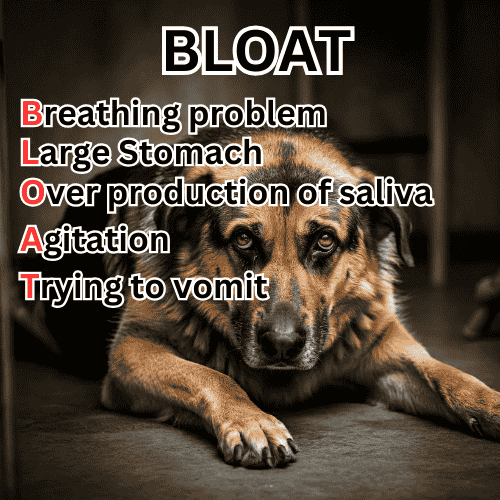
What is Bloat?
Imagine a balloon inflating inside your dog’s stomach. That’s kinda what bloat is like. The stomach fills with gas and fluid, and in some cases, it can even twist on itself, cutting off blood supply and causing serious complications. As described in Bloat in Dogs: The Condition, Causes, Prevention, and Treatment by veterinarian Dr. Joanna Woodnutt, “Bloat is a rapidly progressing condition that requires immediate veterinary intervention.”
Symptoms: Red Alert!
If you notice any of these symptoms in your Rottweiler, seek veterinary attention immediately:
- Swollen Abdomen: Their belly will look distended and might feel hard to the touch.
- Restlessness and Pacing: They’ll seem anxious and unable to settle down.
- Excessive Drooling: They might drool more than usual or have foamy saliva.
- Retching or Trying to Vomit: They might try to vomit but be unable to bring anything up.
- Weakness and Collapse: In severe cases, they might collapse or become unresponsive.
Prevention: Better Safe Than Sorry
While the exact cause of bloat is unknown, there are things you can do to reduce the risk:
- Smaller, More Frequent Meals: Instead of one large meal, feed your Rottweiler two or three smaller meals throughout the day.
- Avoid Strenuous Exercise After Eating: Don’t let your Rottie run or play vigorously for at least an hour after eating.
- Slow-Feed Bowls: If your Rottie tends to gobble their food, a slow-feed bowl can help them eat more slowly.
- Elevated Food Bowls: Some studies suggest that elevated food bowls might reduce the risk of bloat, but more research is needed.
- Talk to Your Vet: Discuss your Rottweiler’s individual risk factors with your vet and get their recommendations for prevention.
Emergency Care: Every Second Counts
Bloat is a true emergency. If you suspect your Rottweiler is experiencing bloat, don’t wait – get them to the vet immediately. The sooner they receive treatment, the better their chances of survival.
Rottweiler Skin Disorders: It's More Than Just a Bad Hair Day
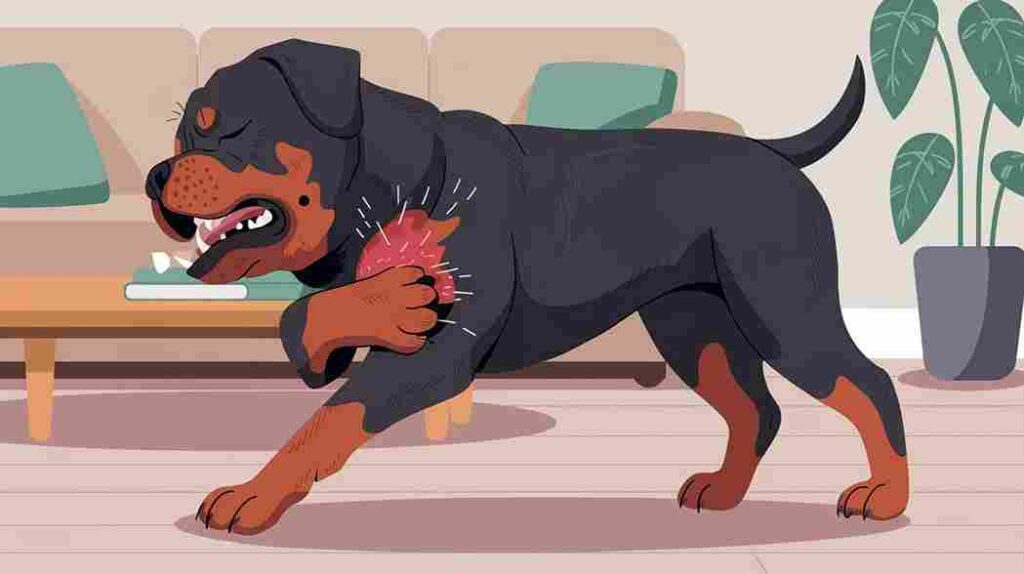
Rottweilers, with their short, sleek coats, might seem like they’d be low-maintenance in the skin department. But these tough guys can actually be prone to a variety of skin woes. From allergies to infections, keeping your Rottie’s skin healthy is an important part of overall care.
Why Rottweilers Are Prone to Skin Problems
A few factors make Rottweilers more susceptible to skin issues:
- Genetics: Just like some people are prone to acne, Rottweilers have a genetic predisposition to certain skin conditions.
- Skin Structure: Their short, dense coat and skin folds can trap moisture and create a breeding ground for bacteria and yeast.
- Allergies: Rottweilers are often sensitive to environmental allergens like pollen, dust mites, and certain foods.
Common Skin Conditions in Rottweilers
Here are some of the most common skin problems you might encounter with your Rottie:
- Allergies: These can cause itching, redness, hair loss, and secondary infections.
- Demodectic Mange: Caused by mites, this can lead to hair loss, scaling, and skin irritation.
- Bacterial Infections: Often occur in skin folds or areas of irritation, causing redness, pustules, and discomfort.
- Yeast Infections: These can cause itching, redness, a musty odor, and greasy skin, often in moist areas like the ears and paws.
- Hot Spots: These are painful, inflamed areas of skin that can develop quickly due to excessive licking or scratching.
Keeping Your Rottie’s Skin Healthy
The good news is that most skin problems in Rottweilers can be managed with proper care and veterinary attention. Here are some key tips:
- Grooming: Regular brushing helps remove dead hair and distribute natural oils, keeping the skin healthy. Pay special attention to skin folds, keeping them clean and dry.
- Bathing: Bathe your Rottie with a gentle, dog-specific shampoo as needed, usually every 2-4 weeks or as recommended by your vet.
- Nutrition: A balanced diet with high-quality ingredients supports skin and coat health.
- Parasite Prevention: Fleas and ticks can cause skin irritation and transmit diseases, so year-round parasite prevention is essential.
- Early Detection: Be vigilant for any changes in your Rottie’s skin or coat, such as excessive scratching, hair loss, or redness. Early detection and treatment can prevent minor issues from becoming major problems.
Want to learn more about Rottweiler skin disorders? Check out our in-depth article: [Rottweiler Skin Disorders: Complete Guide to Symptoms & Treatment (2024)]
Beyond the Big Two: Other Rottweiler Health Concerns
-
Did you know that there are now genetic tests available for some of these conditions? This allows breeders to make informed decisions about breeding and helps reduce the incidence of these diseases in future generations.
While hip dysplasia and bloat are definitely top-of-mind for Rottweiler owners, it’s important to be aware of some other health issues that can affect this breed.
Cancer: A Rottweiler Reality
Sadly, Rottweilers have a higher risk of developing certain types of cancer. As stated in the Rottweiler Health Guide by ImpriMed, “One of the most common causes of death for Rottweilers is cancer.” Some of the most prevalent types include:
- Lymphoma: This is a cancer of the lymphatic system, which plays a crucial role in the immune system.
- Osteosarcoma: This is a type of bone cancer that can be particularly aggressive.
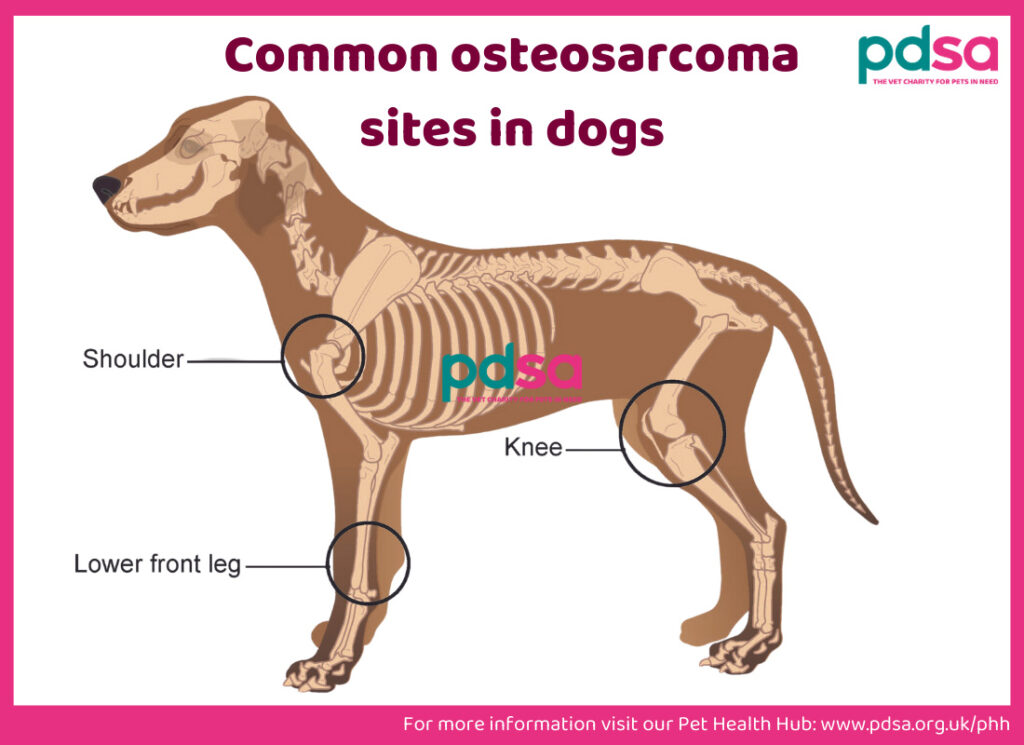
Heart Conditions: Keeping that Ticker Strong
Rottweilers can also be prone to heart problems, with dilated cardiomyopathy (DCM) being a major concern. This condition affects the heart muscle, making it harder for the heart to pump blood effectively. Another potential issue is aortic stenosis, which is a narrowing of the aorta, the main artery that carries blood from the heart to the rest of the body.
Eye Issues: Protecting Their Vision
Rottweilers can also develop certain eye conditions, such as:
- Progressive Retinal Atrophy (PRA): This is a degenerative disease that affects the retina, leading to vision loss and eventually blindness.
- Cataracts: These are cloudy areas that develop in the lens of the eye, causing blurred vision or blindness.
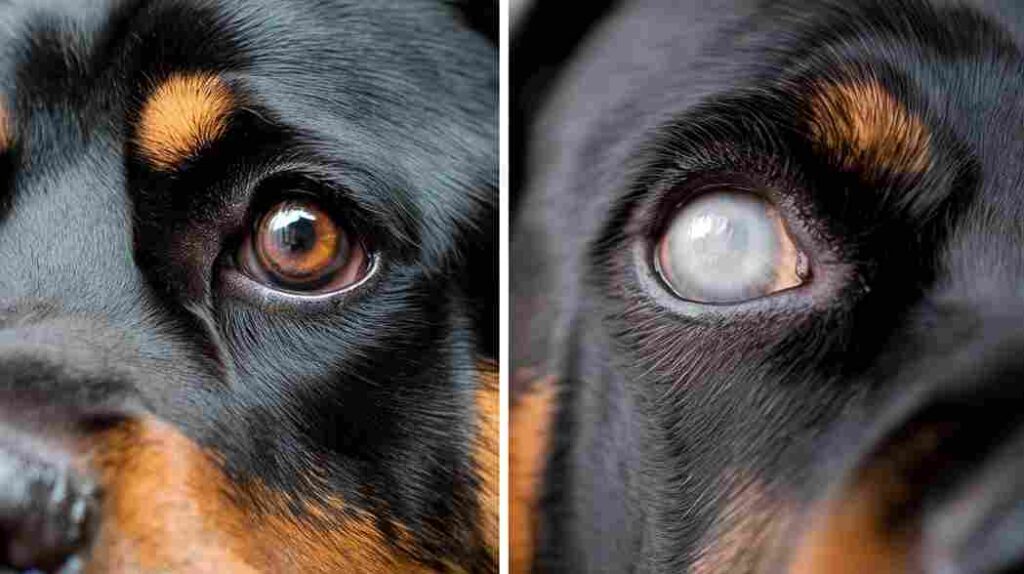
Early Detection is Key:
With many of these conditions, early detection can make a big difference in treatment and management. Regular veterinary checkups, including eye exams and heart screenings, are crucial for catching these issues early on.
Preventative Care: The Best Offense is a Good Defense (Engaging and Informal)
Vaccinations: Your Rottie’s Shield Against Nasty Bugs
Okay, let’s talk about those tiny but mighty warriors in the fight for Rottweiler health: vaccines! Think of them like giving your Rottie a suit of armor against some seriously nasty diseases.
Core vs. Non-Core: The Vaccine Lineup
Not all vaccines are created equal. There are “core” vaccines, which are considered essential for all Rottweilers, and “non-core” vaccines, which might be recommended depending on your Rottie’s lifestyle and risk factors.
- Core Vaccines: These protect against widespread and potentially deadly diseases. As recommended by the American Animal Hospital Association (AAHA), core vaccines for dogs include those that protect against canine distemper virus, canine adenovirus, canine parvovirus, and rabies.
- Non-Core Vaccines: These target diseases that might be more prevalent in certain areas or for dogs with specific lifestyles. Examples include vaccines for kennel cough, leptospirosis, and Lyme disease. Your vet can help you decide which non-core vaccines are right for your Rottie.
Vaccination Schedule: Staying on Track
Keeping your Rottweiler up-to-date on their vaccinations is like giving them a superhero shield against disease. Here’s a general vaccination schedule for puppies, but always check with your vet for personalized recommendations:
- 6-8 weeks: Distemper, adenovirus, parvovirus (often combined in a DHPP vaccine)
- 10-12 weeks: DHPP booster
- 12-16 weeks: Rabies
- 16-20 weeks: DHPP booster (sometimes)
- 12-16 months: DHPP and rabies boosters
- Adult boosters: Typically every 1-3 years, depending on the vaccine and your vet’s recommendations
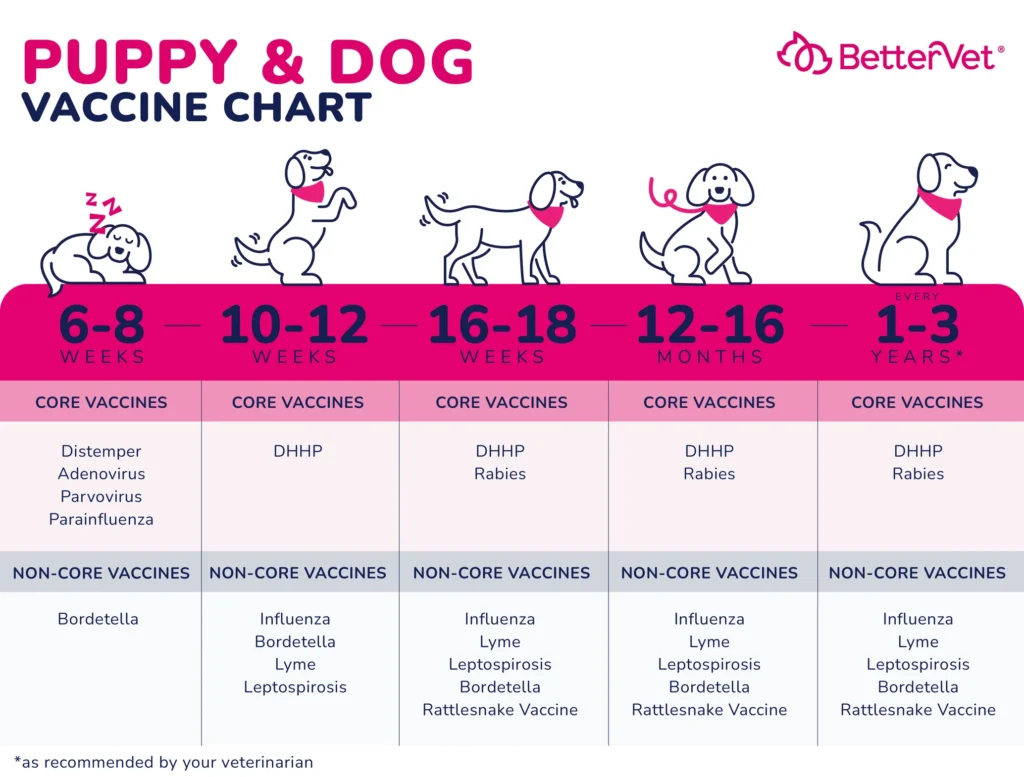
Why Vaccinate? Because Prevention is Powerful
Vaccines stimulate your Rottweiler’s immune system to create antibodies that fight off specific diseases. This helps protect them from getting sick or, in some cases, reduces the severity of the illness if they do get infected.
“Vaccinations are one of the most important preventative health measures you can take for your Rottweiler,” states Rottweilers for Dummies by Richard G. Beauchamp. “They can help protect your dog from a variety of serious and potentially fatal diseases.”
Parasite Prevention: Keeping Those Creepy Crawlies at Bay
-
Did you know that some heartworm preventatives also protect against certain intestinal parasites? Talk to your vet about choosing a product that provides broad-spectrum protection.
Okay, let’s talk about those uninvited guests that can crash your Rottweiler’s health party: parasites! From tiny fleas and ticks to those nasty heartworms lurking in the shadows, these critters can cause a whole lot of trouble for your Rottie.
Fleas and Ticks: Tiny but Mighty Pests
Fleas and ticks aren’t just annoying; they can transmit diseases, cause skin irritation, and even lead to anemia. As stated in the Companion Animal Parasite Council (CAPC) guidelines, “Fleas and ticks are a year-round threat to dogs in many regions.”
- Flea Risks: These tiny bloodsuckers can cause intense itching, allergic reactions, and even transmit tapeworms.
- Tick Troubles: Ticks can transmit a variety of serious diseases, including Lyme disease, ehrlichiosis, and Rocky Mountain spotted fever.
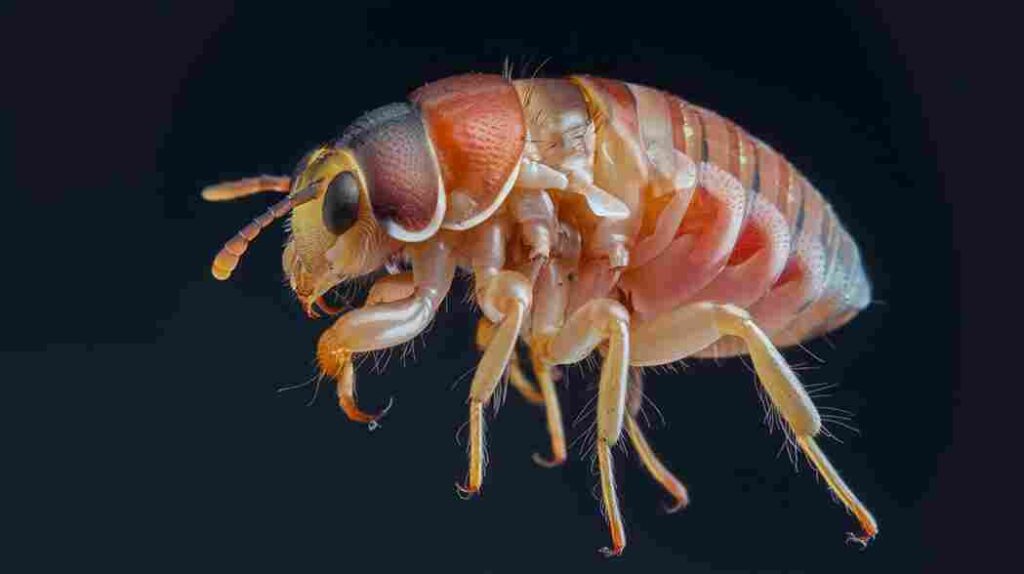
Year-Round Prevention is Key:
Don’t let those creepy crawlies ruin your Rottie’s day! Talk to your vet about the best flea and tick prevention options for your dog. There are various products available, including topical treatments, oral medications, and collars.
Heartworm: A Silent Threat
Heartworm disease is a serious condition that affects the heart and lungs. It’s caused by a type of parasitic worm that’s transmitted through mosquito bites. As described in the American Heartworm Society (AHS) guidelines, “Heartworm disease can cause severe health problems, including heart failure and even death.”
- How it Spreads: Mosquitoes pick up heartworm larvae when they bite an infected animal. They then transmit these larvae to other animals when they bite again.
- Prevention is Crucial: The good news is that heartworm disease is preventable! Talk to your vet about starting your Rottweiler on a monthly heartworm preventative medication.
Intestinal Parasites: Unwelcome Guests in the Gut
Rottweilers can also be susceptible to various intestinal parasites, such as roundworms, hookworms, and whipworms. These parasites can cause digestive problems, weight loss, and even anemia.
Regular deworming is essential for preventing and treating intestinal parasites. Your vet can recommend the appropriate deworming schedule and products for your Rottie.
Dental Care: Those Pearly Whites Need Love Too!
Okay, we’ve covered those big health concerns, but let’s not forget those chompers! Rottweilers have a powerful bite, and keeping those teeth and gums healthy is essential for their overall well-being.
Brushing Basics: Making it a Routine
Brushing your Rottweiler’s teeth might sound a little weird at first, but trust me, it’s a game-changer. Just like us, dogs can get plaque and tartar buildup, which can lead to gum disease, tooth decay, and even bad breath (yuck!).
Here are a few tips to make brushing a breeze:
- Start Early: Introduce toothbrushing when your Rottie is a puppy to get them used to it.
- Use Dog-Specific Toothpaste: Never use human toothpaste, as it can be harmful to dogs. Choose a dog-specific toothpaste that’s safe and tasty (think flavors like chicken or peanut butter!).
- Get the Right Brush: Use a soft-bristled toothbrush designed for dogs, or even a finger brush for easier access.
- Be Gentle: Start with short brushing sessions and gradually increase the time as your Rottie gets more comfortable.
- Make it Positive: Use positive reinforcement, like praise and treats, to make toothbrushing a positive experience.
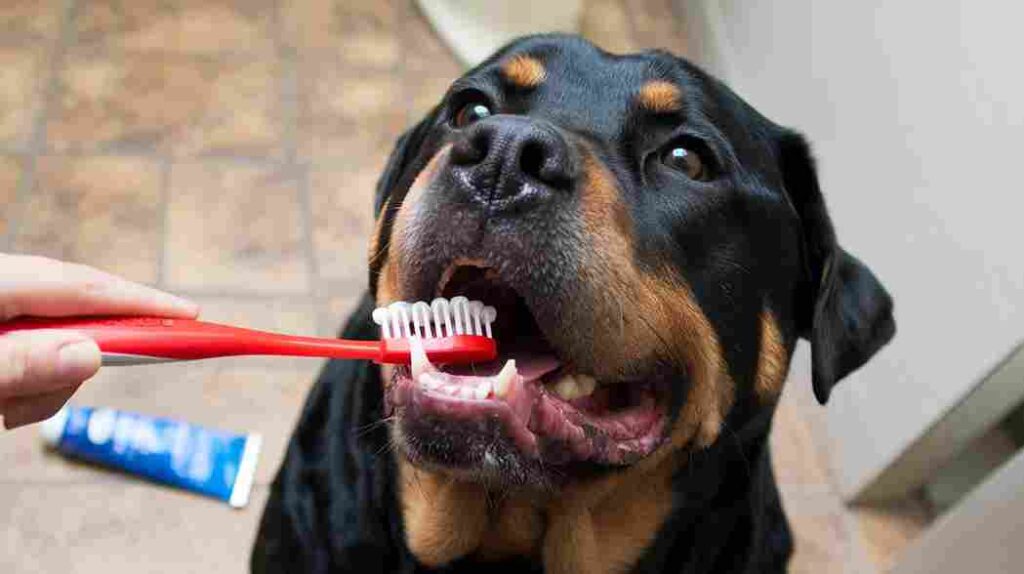
Dental Chews and Treats: The Tasty Way to Clean
If your Rottie isn’t a fan of toothbrushing (and let’s be real, some dogs just aren’t!), there are other options. Dental chews and treats can help scrape away plaque and tartar as your dog chews. Just make sure to choose products that are specifically designed for dental health and approved by the Veterinary Oral Health Council (VOHC).
Professional Cleaning: When Those Chompers Need a Deep Clean
Even with regular brushing and dental chews, your Rottweiler will still need professional dental cleanings from your vet. This involves a thorough cleaning under anesthesia to remove plaque and tartar buildup below the gumline. Think of it like a spa day for their mouth!
-
Did you know that dental disease can actually affect your Rottweiler's overall health? Bacteria from the mouth can enter the bloodstream and cause problems with the heart, kidneys, and other organs. So, keeping those chompers clean is about more than just fresh breath!
Regular Checkups: Keepin' Those Vet Visits Chill (and Less Frequent!)
Okay, nobody loves going to the vet, right? (Except maybe the vets themselves, and those dogs who get extra treats for being good patients.) But regular checkups are like those annoying oil changes for your car – they might seem like a hassle, but they can save you a whole lotta trouble (and money!) in the long run.
How Often Should You Go?
For most adult Rottweilers, a checkup once a year is a good starting point. But your vet might recommend more frequent visits if your Rottie has any underlying health conditions or is getting up there in age (those senior pups need a little extra TLC!).
Early Detection is Key:
Think of those regular checkups as your Rottie’s early warning system. Your vet can catch those sneaky health issues before they become big problems. They’ll give your Rottie a thorough once-over, checking their teeth, ears, eyes, heart, and everything in between. They might also recommend blood work or other tests to get a complete picture of your Rottie’s health.
Why Those Checkups Matter:
- Catch those sneaky problems early: Like we said, early detection is key! Many health issues are easier to treat (and less expensive!) when they’re caught in the early stages.
- Preventative care: Your vet can help you stay on top of preventative care, like vaccinations and parasite prevention.
- Build a relationship with your vet: Regular visits help you build a relationship with your vet, so they’re familiar with your Rottie’s health history and can provide personalized care.
- Peace of mind: Knowing that your Rottie is getting regular checkups can give you peace of mind and help you feel confident that you’re providing the best possible care.
-
Regular vet visits can actually help reduce your overall vet bills in the long run! By catching and treating health issues early, you can avoid more serious (and expensive) problems down the road.
Okay, time for a little story! This is about my own Rottweiler, Luna, and how those “annoying” vet checkups actually saved her from a whole lotta trouble.
Luna, like most Rotties, is a total food fiend. If it’s edible (and sometimes even if it’s not…), she’ll try to eat it. So, you can imagine my panic when she started throwing up and having diarrhea out of the blue. Of course, I rushed her to the vet, fearing the worst (bloat, maybe? A sock obstruction? Who knows what that dog gets into!).
Turns out, it was a simple case of gastroenteritis, probably from something she scavenged on one of our walks. But here’s the kicker: during the checkup, my vet noticed a small lump on Luna’s belly that I hadn’t even felt. It turned out to be a benign fatty tumor, but it could have easily gone unnoticed if we hadn’t been there for the upset tummy.
The vet was able to remove the tumor before it caused any problems, and Luna was back to her goofy self in no time. That experience really drove home the importance of those regular checkups. They’re not just about treating illnesses; they’re about catching those hidden issues and preventing bigger problems down the road. So, yeah, maybe those vet visits aren’t so annoying after all!
Conclusion: Rottweilers in Motion, a Sight to Behold
From those powerful legs and balanced physique to their ground-covering trot and impressive agility, it’s clear that Rottweilers are truly remarkable athletes. Their movement is a testament to their working heritage, their strength, and their enduring spirit.
A Final Thought:
As Rottweiler owners, it’s our responsibility to support their physical and mental well-being by providing them with opportunities to move, explore, and engage their athletic abilities. By nurturing their innate athleticism, we not only contribute to their physical health but also foster their confidence, happiness, and overall zest for life. So, let’s keep those Rottweilers moving, exploring, and thriving!
Whether they’re herding livestock, competing in agility trials, or simply enjoying a playful romp in the park, Rottweilers demonstrate a grace and power that’s truly captivating. Their ability to seamlessly transition from a powerful trot to a playful prance is a testament to their versatility and adaptability.
Nutrition: Fueling Your Rottweiler's Health (Concise and Structured)
Okay, let’s talk fuel! Just like a high-performance car needs the right kind of gas, your Rottweiler needs the right kind of food to keep those engines running smoothly.
Life Stages:
- Puppyhood: Building a Foundation
Those adorable Rottweiler puppies might look like tiny fluffballs, but they’re growing at warp speed! And to support those growing bones and muscles, they need a diet that’s packed with the good stuff. (Learn more about Rottweiler puppy training in our complete guide: “Rottweiler Puppy Training: Your First 6 Months.”)
- Large-Breed Puppy Food: This is crucial! Large-breed puppy formulas are specifically designed to support healthy growth and prevent skeletal problems that can occur in rapidly growing large-breed dogs. Look for a food that’s AAFCO-approved and meets the nutritional needs of large-breed puppies.
- Key Nutrients: Protein is essential for muscle development, while calcium and phosphorus are crucial for strong bones. And don’t forget those healthy fats for a shiny coat and brain development!
Adulthood: Maintaining Peak Performance
Once your Rottie reaches adulthood (around 12-18 months), it’s time to transition them to an adult dog food. But with so many options out there, how do you choose the right one?
- Activity Level: Is your Rottie a couch potato or an athlete? Active dogs need more calories and protein than less active dogs.
- Health Considerations: Does your Rottie have any specific health needs, like allergies or joint problems? There are specialized formulas available for dogs with various health conditions.
- Quality Ingredients: Look for a food with high-quality animal protein as the first ingredient, and avoid fillers and artificial additives.
Ready to master advanced commands and skills with your Rottweiler? Our guide to advanced Rottweiler training covers everything from off-leash reliability to impressive tricks: Rottweiler Advanced Training: Level Up Your Rottie’s Skills.”
Senior Years: Adapting to the Golden Age
As your Rottweiler enters their golden years (around 7-8 years old), their nutritional needs change again. Senior dogs often have lower energy levels and might benefit from a diet that’s lower in calories but higher in certain nutrients.
- Senior-Specific Formulas: These formulas are often easier to digest and might include ingredients that support joint health, cognitive function, and a healthy immune system.
- Adjusting Feeding Routines: Senior dogs might need smaller, more frequent meals, and you might need to adjust their diet based on any age-related health conditions.
-
Did you know that Rottweilers can be prone to food allergies? Common allergens include beef, chicken, dairy, and wheat. If you notice any signs of allergies, such as itching, digestive issues, or ear infections, talk to your vet about switching to a hypoallergenic diet.
Feeding Guidelines: Portion Control and Label Literacy
Okay, you’ve got that perfect Rottweiler food picked out. But how much should you actually feed your Rottie? And how do you decipher those confusing dog food labels?
Portion Control: Finding the Right Balance
Rottweilers are big, powerful dogs, so they need a decent amount of food to fuel their adventures. But overfeeding can lead to obesity and other health problems, so portion control is key.
- Age: Puppies need more calories per pound of body weight than adult dogs because they’re growing. Senior dogs, on the other hand, might need fewer calories as their metabolism slows down.
- Activity Level: A couch potato Rottie won’t need as much fuel as a Rottie who’s training for agility competitions or herding sheep all day.
- Individual Needs: Some Rottweilers are simply more prone to weight gain than others. Your vet can help you determine the ideal weight and calorie intake for your individual dog.
Reading Food Labels: Decoding the Dog Food Mystery
Those dog food labels can be confusing, right? Here’s a quick guide to help you decipher the important stuff:
- Ingredient List: The first ingredient should be a high-quality animal protein, like meat or meat meal. Avoid foods with fillers like corn, wheat, or soy as the main ingredients.
- Guaranteed Analysis: This section shows the minimum percentages of crude protein, fat, fiber, and moisture in the food. Look for a food that meets the AAFCO (Association of American Feed Control Officials) standards for your Rottie’s life stage.
- Nutritional Adequacy Statement: This statement indicates whether the food is “complete and balanced” for your Rottie’s life stage (puppy, adult, or senior).
- Calorie Content: This tells you how many calories are in each serving of food. Use this information to calculate your Rottie’s daily calorie needs and adjust portion sizes accordingly.
-
Did you know that feeding your Rottweiler smaller, more frequent meals can help reduce the risk of bloat? It also helps them feel more satisfied throughout the day.
Weight Management: Keeping Your Rottie Trim and Terrific
Okay, let’s talk about those extra pounds. We all love to spoil our Rotties with treats and cuddles, but those extra snacks can add up! And just like with humans, obesity in Rottweilers can lead to a whole bunch of health problems.
Obesity Risks: More Than Just a Few Extra Pounds
Carrying extra weight puts a strain on your Rottweiler’s body, increasing their risk of:
- Joint Problems: Those already-vulnerable hips and elbows have to work even harder to support the extra weight, increasing the risk of arthritis and other joint issues.
- Heart Disease: Obesity can lead to heart disease, making it harder for their heart to pump blood efficiently.
- Diabetes: Overweight dogs are more likely to develop diabetes, a condition that affects their ability to regulate blood sugar.
- Respiratory Problems: Extra weight can make it harder for them to breathe, especially during exercise or in hot weather.
- Reduced Lifespan: Sadly, obesity can shorten your Rottweiler’s lifespan and reduce their overall quality of life.
Maintaining a Healthy Weight: Tips for a Trim Rottie
- Portion Control: Measure your Rottie’s food carefully and avoid free-feeding (leaving food out all day). Follow the feeding guidelines on the food label and adjust portions based on your dog’s age, activity level, and individual needs.
- Regular Exercise: Daily exercise is crucial for burning calories and maintaining a healthy weight. Make sure your Rottie gets plenty of opportunities to run, play, and explore.
- Treat Wisely: Those delicious treats can add up quickly! Choose healthy, low-calorie treats and use them in moderation. You can also use a portion of their regular food as training treats.
- Monitor Their Weight: Keep an eye on your Rottie’s weight and body condition. You should be able to feel their ribs easily, but they shouldn’t be overly prominent. If you’re unsure, ask your vet for guidance.
-
Did you know that even a small amount of weight loss can make a big difference in your Rottweiler's health and well-being? Losing just 10% of their body weight can significantly reduce their risk of developing obesity-related health problems.
Food Allergies: When Your Rottie's Tummy Says "No Way!"
We all know Rottweilers love to eat, but sometimes, their tummies just don’t agree with certain foods. Food allergies in Rottweilers can be a real pain (literally!), causing a range of uncomfortable symptoms.
Common Culprits: The Usual Suspects
Just like with humans, Rottweilers can be allergic to a variety of ingredients. Some of the most common culprits include:
- Beef: It might seem surprising since beef is a common protein source in dog food, but it’s actually a frequent allergen for Rotties.
- Chicken: Another common protein that can trigger allergies in some dogs.
- Dairy: Milk, cheese, and other dairy products can cause digestive upset and skin problems in dogs with dairy allergies.
- Wheat: This grain is often found in dog food, but it can be a problem for dogs with wheat allergies or sensitivities.
- Soy: Soy is another common ingredient in dog food that can trigger allergic reactions in some Rottweilers.
Signs and Symptoms: Itchy, Scratchy, and Uncomfortable
Food allergies can manifest in a variety of ways, so it’s important to be aware of the signs:
- Skin Problems: Itching, scratching, redness, hot spots, and hair loss are common signs of food allergies.
- Digestive Upset: Vomiting, diarrhea, gas, and abdominal discomfort can also be signs of food allergies.
- Ear Infections: Chronic ear infections can sometimes be linked to food allergies.
[Image suggestion: A photo of a Rottweiler scratching or with irritated skin.]
Dietary Changes: Finding the Right Food Formula
If you suspect your Rottweiler has a food allergy, it’s important to work with your vet to identify the culprit and make dietary changes. This often involves an elimination diet, where you feed your Rottie a novel protein (a protein they haven’t eaten before) and gradually reintroduce other ingredients to identify the trigger.
Your vet might also recommend a hypoallergenic diet, which is specially formulated to be free of common allergens. These diets often contain hydrolyzed protein, which is broken down into smaller pieces that are less likely to trigger an allergic reaction.
-
Did you know that food allergies can develop at any age? Even if your Rottweiler has been eating the same food for years without any problems, they can still develop an allergy to it later in life.
Exercise: Keeping Your Rottie Active and Happy
Okay, let’s talk about those zoomies! Rottweilers are built for action, and they need a good dose of exercise to keep those bodies and minds happy and healthy.
Exercise Needs: Fueling the Fun
Think of your Rottweiler as a furry, four-legged sports car. They need to stretch those legs, burn off some energy, and feel the wind in their fur (okay, maybe not literally, but you get the idea!).
- Daily Dose of Movement: Most adult Rottweilers need at least 60-90 minutes of exercise per day. And don’t just think walks around the block! Mix it up with jogs, playtime in a securely fenced area, hikes, or even swimming (if they’re into that sort of thing).
- Mind Games: But it’s not just about physical exercise. Rottweilers are smart cookies, and they need mental stimulation too. Puzzle toys, obedience training, and interactive games can help keep their minds sharp and prevent boredom.
Why Exercise Matters:
- Happy Body, Happy Rottie: Exercise helps maintain a healthy weight, keeps their joints flexible, and strengthens their muscles. It also helps prevent those pesky behavioral issues that can pop up when a Rottie has too much pent-up energy.
- Bonding Time: Exercise is a great way to bond with your Rottie and build a strong relationship. Plus, let’s be honest, those happy Rottie grins after a good play session are priceless!
- Stress Buster: Exercise helps reduce stress and anxiety, both for you and your Rottie. It’s like a therapy session for both of you!
-
Did you know that Rottweilers were originally bred to herd cattle and pull carts? So, those athletic genes are deeply ingrained in their DNA. They're practically begging you to take them on an adventure!
Types of Exercise: Finding Your Rottie's Fitness Groove
Okay, we know those Rotties need to move, but what kind of exercise is best? The good news is, Rottweilers are pretty versatile athletes, so you’ve got options!
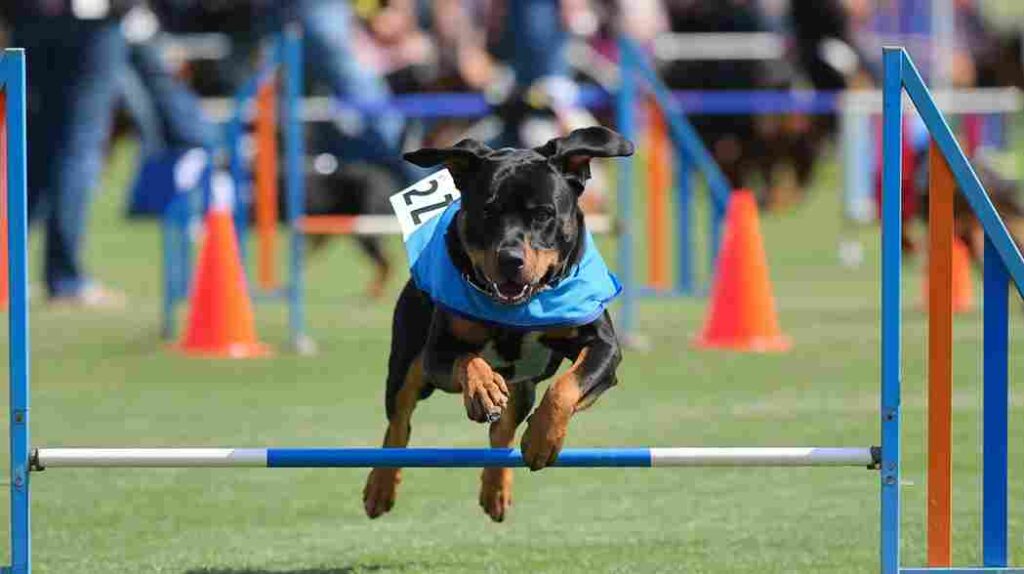
Walks and Jogs: The Classics
There’s a reason why walks are a dog-walking staple. They’re a great way for your Rottie to stretch their legs, explore the neighborhood, and sniff all those fascinating smells (seriously, have you ever seen a dog sniff a fire hydrant?).
- Benefits: Daily walks help maintain a healthy weight, improve cardiovascular health, and provide mental stimulation. Plus, it’s a great way to bond with your Rottie and get some fresh air yourself.
- Jogging Buddies: If you’re a runner, your Rottie might make a great jogging partner! Just make sure they’re physically fit enough for jogging and gradually increase the distance and intensity to avoid overexertion.
Playtime: Unleashing the Inner Puppy
Rottweilers might look tough, but they’re big softies at heart who love to play! Interactive playtime is a fantastic way to burn energy, strengthen your bond, and provide mental stimulation.
- Fetch Fanatics: Most Rotties go bonkers for a good game of fetch. It’s a classic for a reason! Just make sure to use a safe, durable toy and avoid throwing it too high or on hard surfaces to prevent injuries.
- Tug-of-War Champions: If your Rottie has a strong prey drive, a game of tug-of-war can be a great outlet. Just remember to establish clear rules and end the game if it gets too intense.
Dog Sports: Taking it to the Next Level
If your Rottie is a true athlete, consider getting involved in dog sports! There are plenty of options that cater to their strength, intelligence, and athleticism.
- Agility Aces: Rottweilers can excel in agility courses, navigating jumps, tunnels, and weave poles with surprising speed and precision.
- Obedience Stars: Rottweilers are highly trainable and can shine in obedience competitions, showcasing their responsiveness and focus.
- Tracking Experts: With their keen sense of smell, Rottweilers can also excel in tracking sports, following scent trails to locate hidden objects or people.
Swimming: The Low-Impact Workout
Swimming is a fantastic low-impact exercise for Rottweilers, especially those with joint problems or who are recovering from injuries. It’s a great way to build muscle, improve cardiovascular health, and provide a full-body workout without putting stress on their joints.
Fun Fact: Not all Rottweilers are natural swimmers! Some might need a little encouragement and a doggy life vest to feel comfortable in the water.
Exercise Precautions: Safety First for Your Super Athlete
Okay, we’ve hyped up those Rottie athletic abilities, but even the strongest athletes need to take precautions. Safety first, right?
Warm-up and Cool-down: Easing into Action
Just like you wouldn’t jump into a marathon without stretching first, your Rottweiler needs a warm-up before those intense play sessions or jogs. A few minutes of walking or light play can help get their muscles and joints ready for action. And don’t forget the cool-down! A gentle walk after strenuous activity helps prevent stiffness and soreness.
Avoiding Overexertion: Knowing Your Rottie’s Limits
Rottweilers are eager to please and might push themselves too hard, especially in hot weather. Keep an eye out for signs of overexertion, like excessive panting, drooling, or lagging behind on walks. And always provide plenty of water breaks, especially during those summer scorchers.
Safe Surfaces: No Slipping and Sliding
Those powerful paws need good traction! Exercise your Rottweiler on safe, non-slip surfaces to prevent injuries. Avoid slippery floors, icy sidewalks, or uneven terrain that could cause strains or sprains.
Senior Rottweilers: Adapting to the Golden Years
As your Rottie enters their golden years, it’s important to adjust their exercise routine to match their changing needs. They might not have the same stamina as they did in their younger days, but they still need regular activity to stay healthy and happy.
- Shorter and Sweeter: Instead of those long jogs, opt for shorter, more frequent walks.
- Low-Impact Activities: Swimming is a fantastic option for senior Rotties, as it provides a great workout without putting stress on their joints. Gentle walks, playtime in the yard, and even some indoor games can also keep them active.
- Listen to Your Rottie: Pay attention to their cues. If they seem tired or reluctant to exercise, it’s time to take a break or switch to a less strenuous activity.
-
Regular exercise can actually help slow down the aging process in dogs! It helps maintain muscle mass, keeps their joints flexible, and supports cognitive function. So, even in their golden years, keep those Rotties moving!
We’ve covered a lot of ground here, from those powerful Rottweiler paws to those pearly white teeth (and everything in between!). And while Rottweilers are known for their strength and resilience, they’re not invincible. They need our help to stay healthy and thrive.
By being proactive about their health care – from those essential vet checkups to those daily walks and those sometimes-challenging toothbrushing sessions – we can give our Rotties the best chance at a long, happy, and adventure-filled life.
A Final Thought:
There’s nothing quite like the bond we share with our Rottweilers. Their loyalty, love, and goofy personalities make them truly special companions. By prioritizing their health and well-being, we not only give them the gift of a long life but also deepen that incredible bond and create memories that will last a lifetime. So, let’s raise a paw (or a toothbrush!) to happy, healthy Rottweilers everywhere!
FAQs: Your Burning Questions Answered!
1. What are the most common health problems in Rottweilers?
Answer: Rottweilers are prone to hip and elbow dysplasia, bloat, certain types of cancer (like lymphoma and osteosarcoma), and heart conditions (such as dilated cardiomyopathy).
2. How often should my Rottweiler see the vet?
Answer: Annual checkups are recommended for most adult Rottweilers, but puppies and senior dogs might need more frequent visits.
3. What are the signs of bloat in a Rottweiler?
Answer: Bloat symptoms include a swollen abdomen, restlessness, excessive drooling, retching, and attempts to vomit. Bloat is an emergency, so seek immediate veterinary attention if you suspect it.
4. What can I do to prevent hip dysplasia in my Rottweiler?
Answer: Choose a reputable breeder who screens their dogs for hip dysplasia, provide proper nutrition, and avoid excessive or high-impact exercise during puppyhood.
5. How much exercise does a Rottweiler need?
Answer: Most adult Rottweilers need at least 60-90 minutes of exercise per day, including walks, playtime, and mental stimulation.


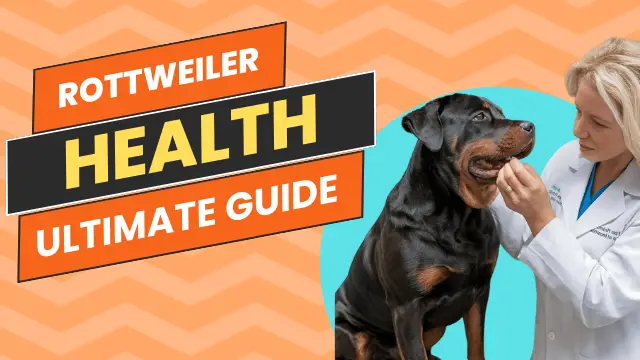



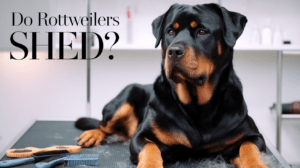

Pingback: Myths About Long-Haired Rottweiler Debunked
Pingback: American Rottweiler vs German Rottweiler: Busting the Breed Myths!